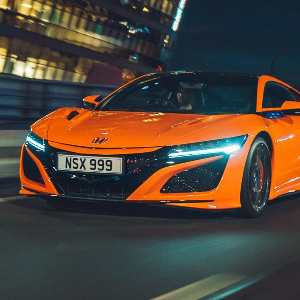
The Porsche 911 might be available in many forms, but it’s at its purest when the letter and number combination GT3 is applied to its engine cover. The GT3 is the model that homologates Porsche's racing cars, legitimising its on-track success with a road car that’s very close to those racers in its specification. A new GT3 is a big deal then, and keenly awaited by enthusiastic drivers all over the world.
The new GT3 is based on Porsche’s latest 911, which if you’re up to speed on Porsche code names is the 992 series. The production car will be in showrooms early in 2021, we have scored a ride alongside Andreas Preuninger, Porsche’s Director, GT Line production cars, in one of the prototypes in which he’s doing some final testing. It’s a rare opportunity to have such a preview of what to expect from the new GT3, and to quiz the GT boss about what is, without question, one of the most hotly anticipated driver’s cars to arrive in the next 12 months.
Preuninger is quick to point out a few things about the new GT3. It’s bigger, yes, that inevitable because of the larger 992 series car it’s based on, but, crucially, it’s no heavier. The GT3 is always a car where the scales are important, and via a rigorous weight loss exercise the GT department has created a GT3 that adds no more weight to the previous one.
To achieve that it’s taken the usual GT3 route of removing any excess; you’ll not find any rear seats, there’s less sound deadening, there are polyurethane bumpers front and rear, thinner glass on every window except the windscreen and, a first on a full production GT3 – as opposed to a limited-run model or option pack – a carbon fibre bonnet. Unlike any GT3 produced to date, the 992 GT3 won’t be offered with the possibility to delete the air-conditioning, because, as so few people ever did that, Porsche has removed the opportunity to do so.
The weight stays the same as its predecessor, then, and so does the engine specification. It’s been an open secret since the limited-edition 991.2 Speedster was launched in 2019 that the 992 version of the GT3 would get the same glorious, high-revving, 4.0-litre naturally-aspirated flat-six under its engine cover. And so it proves. Naturally, there have been some necessary changes to enable it to pass future emissions and noise regulations, but it’s essentially the same engine, pushing out a quoted 510hp and revving to 9,000rpm. That’s 10hp more than the previous GT3 (but identical to the Speedster), so not a big increase in power, Preuninger stating that the GT3’s greatest gains are generated elsewhere.
Specifically, those improvements are in relation to the aerodynamics and the chassis. All GT3s bully the air into achieving exactly what it wants it to do, but with the new 992 GT3 there’s a marked difference. Taking lessons learned from its racing siblings – things like the big hung rear wing high above the engine cover – the GT3 produces 50% more downforce, but it does so without any increase in drag. That’s quite a trick, that aerodynamic efficiency creating the unlikely partners of great high speed stability, yet allowing forceful acceleration at speed. That’s something that Preuninger highlights as key, not just for the lap times that the GT3 will inevitably be judged by, but to allow the GT3 to accelerate with conviction right up to 300km/h (186mph) on Germany’s un-restricted autobahns. To prove the point we do exactly that, the GT3 feeling incredibly composed at high speeds, the engine behind filling the pared-back, but far from stripped, interior with familiar, sonorous and rousing GT3 engine notes.
For all the talk of high speed aerodynamic efficiency it’s on slower, more challenging roads where the GT3 reveals so much more. Agile and secure, the biggest surprise is how supple the suspension is. That is despite its clear focus and spring rates up around 25% over the previous GT3. A number of factors allow this, not least the GT department’s expertise in tuning the dampers, the ride doubly remarkable due to the absence of bushing in the suspension set-up. The rear axle is carried over from the outgoing GT3, that being a multi-link system with rear-wheel steering, but at the front it’s completely new.
Under that wider front track of the 992 GT3 is a suspension system lifted from Porsche’s racing cars. The MacPherson struts of conventional 911s have been replaced by double wishbones in forged aluminium. They’re advantageous because there’s less friction in the suspension, it’s quicker reacting and increases the stability under braking. From the passenger seat if feels it, the GT3’s nose quick to respond to Preuninger’s inputs at the wheel, with that agility seemingly shrinking the 992’s proportions on the road.
There’s a wider wheel up front, the 20-inch forged alloy wheel being 9.5-inches wide and wearing 255/35 ZR20 Michelin Pilot Sport Cup 2s tyres. The rear wheel grows to 21-inches in diameter and is 12-inches wide, with the rear tyres being 315/30 ZR21s. Behind the lightweight centre-lock wheels are bigger brakes, now 408mm on the front axle, the rears being 380mm, these, again like the racers, being surface drilled rather than through drilled for greater performance and longevity. A PCCB (Porsche Ceramic Composite Brakes) option will, of course, be offered, too, these reducing the unsprung mass considerably, but being an expensive addition over the already excellent standard brakes.
Other options will include a front axle lift system, a choice of comfort, powered, seats or sports bucket items, as well as the usual Clubsport package that brings an interior cage and an electric kill switch, fire extinguisher system and multi-point race harnesses if you’re likely to use the GT3 at the track a lot. The interior is GT3 specific, with its own instrumentation and shift lights arcing around the central rev-counter, and the numerous drive mode possibilities of the standard 911 reduced to just three in the GT3. They’ll be Normal, Sport and Track, each configurable, and altering things like the suspension, exhaust, engine response and the thresholds of the stability and traction control systems.
The other significant decision with your GT3 will be whether you want a PDK seven-speed automatic, or the six-speed manual, the PDK coming with a big transmission-tunnel mounted gear selector as well as wheel-mounted paddles-shifters - because Preuninger prefers to shift the seven-speed automatic that way. What’s new with the 992 GT3 will be that both transmission choices will be offered with both the winged standard GT3, or its more sober-suited, de-winged Touring alternative. They’ll be in showrooms early in 2021, giving enthusiastic drivers something to really look forward to after what’s been a less than brilliant 2020. After a day in the passenger seat with the man responsible for it, the GT3 looks, feels and sounds like it’s going to be well worth the wait.

